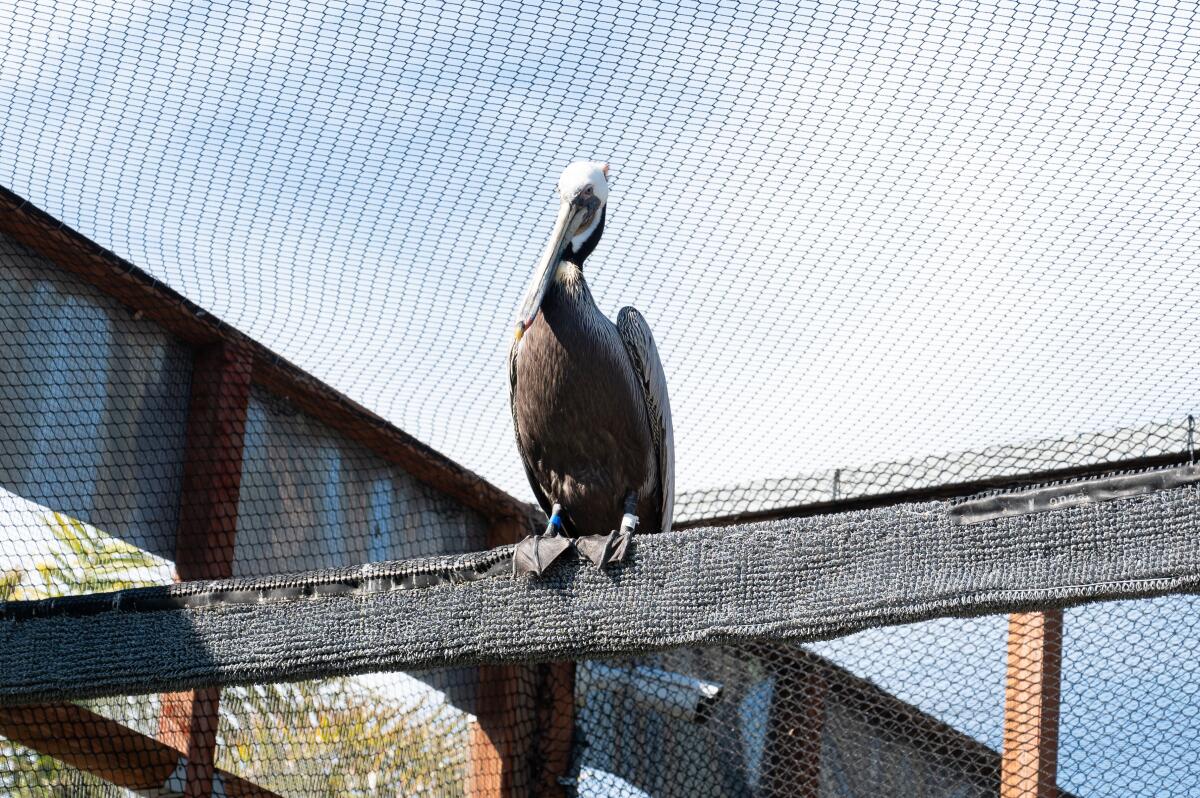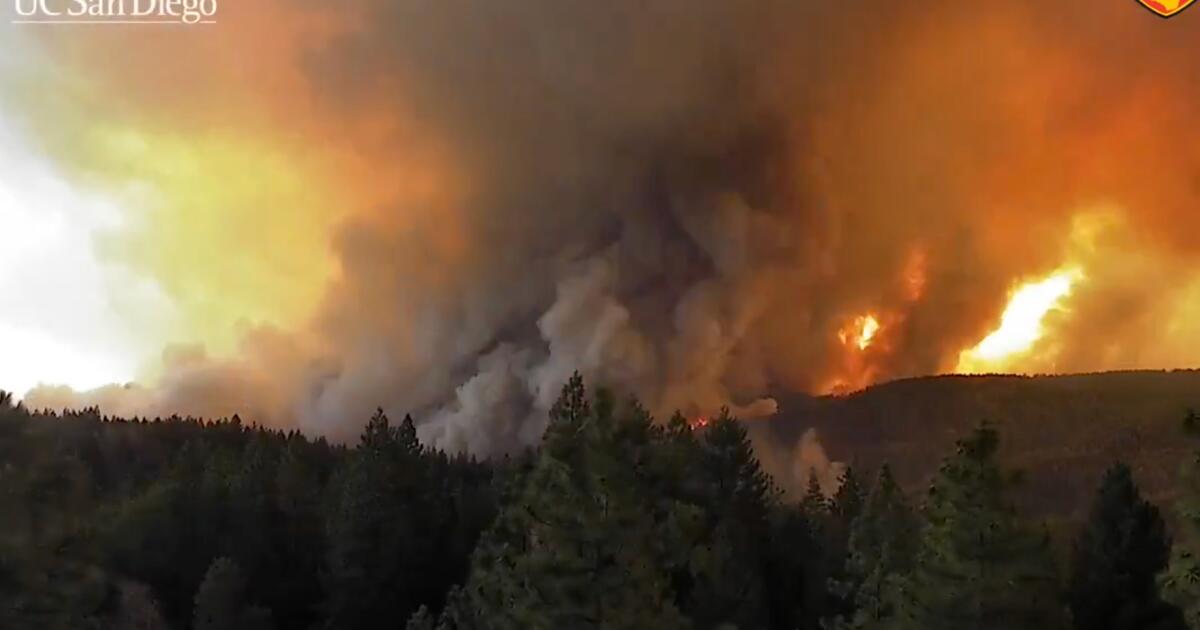World News
Injured brown pelican ‘Blue’ continues healing process

A 3-year-old brown pelican hobbled about the San Pedro Pier, injured and unable to feed itself for at least a day.
Cuts ran parallel to the jaw, straight and through to the back of the neck and into the feathered skin, according to reports from a bird rescue group.
A member of a local sport-fishing crew spotted the disoriented bird March 10 and tossed it a fish. The pelican caught it with its beak, but the snack slid out of its exposed and damaged pouch.
The fisherman drove the bird two miles to International Bird Rescue, which is known for providing care and rehabilitation services.
The organization announced Thursday that the brown pelican, christened “Blue,” is improving, “eating with bravado” and has gained nearly two pounds.
“We got the bird quickly, and it’s fair to say that Blue is on the road to recovery,” said Russ Curtis, the group’s communications manager. “The bird is eating, and it has a bright future.”
Curtis said the pouch is a “vital organ” for brown pelicans that allows the birds to scoop up and swallow fish.

Blue at International Bird Rescue’s aviary. The organization believes the wounds were man-made.
(Russ Curtis / International Bird Rescue)
“If it’s cut, it’s a death sentence,” Curtis said.
Curtis said Blue required 400 immediate stitches, performed by the organization’s chief veterinarian, Dr. Rebecca Duerr. Another 100 stitches were added after Blue rested for five to six days, to sew up the rest of the exposed mouth area, Curtis said.
“The back of Blue’s mouth required careful reconstruction but came together well,” Duerr said.
Blue spent Friday morning and afternoon in International Bird Rescue’s flight aviary. The group posted a YouTube video Thursday of the brown pelican attempting to grab small fish out of a blue crate.
“We want to thank the bird lovers of Southern California and beyond for their support of our efforts to save Blue,” Chief Executive JD Bergeron said in a statement.
Duerr and other International Bird Rescue staffers believe humans inflicted the injuries on the bird.
“We see many pelicans with pouch trauma due to fishing gear and eating dangerous, sharp items like fish skeletons, but the wounds do not look like this,” said Duerr, director of research and veterinary science. “The cuts are reminiscent of a knife, machete or other sharp object.”
The injuries reminded staffers of an attack 10 years ago on a Long Beach brown pelican called “Pink.” International Bird Rescue officials labeled that incident “the worst deliberate pouch slashing we’ve ever seen.”
Pink needed two surgeries and almost two months of recovery at the same aviary where Blue is convalescing. Pink was released at San Pedro’s seaside White Point Park in June 2014. Blue was named as an homage to Pink.
The assault on Blue is the first one thought to be by a human that International Bird Rescue has come across this year, according to Curtis.
“I don’t know what would lead a person to attack a bird, out just looking for food, so cruelly,” he said. “It’s a sad statement about the world.”
The injury was reported to the California Department of Fish and Wildlife for investigation.
Capt. Patrick Foy, a member of the department’s enforcement division, said he was aware of a handful of birds with injured pouches over the last several years between Ventura and Dana Point. However, his division could not identify what or who was wounding them.
“There’s no doubt these birds have been horribly injured,” Foy said. “Whether it’s caused by a human has not been proven yet.”
Foy said his department could not conclude that a human was responsible for the attacks until the animals are inspected.
Until then, he said, “we have an investigation that is ongoing, but we have very little to go on.”
Foy and International Bird Rescue have a tip line at 888-334-2258 and hope members of the public will provide information.
World News
France travel disruption expected to last for days

French rail company SNCF has warned that disruption from Friday’s sabotage against the country’s train network could last until the end of the weekend and affect hundreds of thousands more passengers.
Coordinated arson attacks on three lines of the high-speed TGV network on Friday caused chaos for travellers, hours before the opening ceremony for the Paris Olympics. A fourth attack was thwarted by rail workers.
Prime Minister Gabriel Attal described the attacks as “acts of sabotage”.
About a quarter of international Eurostar trains were also cancelled, with UK Prime Minister Keir Starmer among those affected.
In a statement issued on Friday evening, SNCF said traffic “would improve” on affected lines on Saturday thanks to the work of thousands of rail workers.
It said:
- On the eastern line, trains would run normally from 06:00 (05:00 BST) on Saturday
- On the northern line, 80% of trains would be running, with delays of 1-2 hours
- On the south-western line, 60% of trains would be running, with delays of 1-2 hours
The company added that customers whose trains are delayed or cancelled will be contacted by email or text message.
Eurostar said it expected about a fifth of services over the weekend would be cancelled, while all trains would face delays of around 1.5 hours. Eurostar services use the northern high-speed line.
SNCF said surveillance of the rail network had been strengthened “on land and in the air,” using 1,000 workers and 50 drones.
Junior Transport Minister Patrice Vergriete said around 250,000 people had been affected on Friday, while up to 800,000 could face delays and cancellations by Monday.
He added that disrupting holiday travel, rather than Friday’s Olympic opening ceremony, was the most likely aim of the saboteurs.
“There is not necessarily a link” with the Olympics, he said in an interview.
Friday 26 July traditionally marks the start of the grand départ (big getaway) for many French holidaymakers heading out of the cities.
No group has yet claimed that it was behind the attacks. A source linked to the investigation told the AFP news agency that the operation was “well prepared” and organised by “a single structure”.
Mr Attal said security forces were searching for those responsible.
At around 04:00 on Friday, saboteurs cut and set on fire specialised fibre optic cables essential for the safe functioning of the rail network, government officials said.
One site was at Courtalain, 150km (93 miles) south-west of Paris. A picture posted online purportedly showed burnt-out cables in a shallow gulley with its protective SNCF paving stones discarded.
The SNCF spoke of a “massive, large-scale attack aimed at paralysing” its services, not just at Courtalain but at Pagny-sur-Moselle, a village outside the eastern city of Metz and Croisilles, not far from the northern city of Arras.
Another attempted attack in Vergigny, south-east of Paris, was foiled by SNCF workers who were carrying out maintenance on site in the early hours of Friday.
Prosecutors have opened an investigation into attacks on “the fundamental interests of the nation”.
World News
‘Firenado’ spotted above explosive Park fire near Chico

As the state’s largest wildfire of the year was doubling in size Thursday evening, explosive flames spun up into the atmosphere, swirling in a way that can only be described as tornado-like — a real life example of the firenado phenomenon.
Video of the massive fire whirl was captured by AlertCalifornia wildfire cameras, displaying the extreme fire behavior that is driving the massive and fast-moving Park fire across Butte and Tahoma counties.
The blaze has grown past 178,000 acres as of Friday afternoon, forcing thousands of evacuations and burning more than 100 buildings. Officials say the fire started Wednesday in Chico due to an act of arson.
“At this point, the fire is kind of creating its own weather, and that can be pretty unpredictable,” said Courtney Carpenter, a meteorologist with the National Weather Service in Sacramento. “Really big, explosive wildfires can create thunderstorms. They can make whirling fire plumes that can mimic tornadoes.”
Meteorologists tracked those massive, rotating smoke plumes on the radar Thursday night, Carpenter said, a characteristic of “explosive fire growth.”
She said the wildfire also generated thunderstorm clouds, but didn’t quite trigger lightning, which some particularly unstable fires have created before.
Watching the fire produce massive smoke rotations — and maybe even several vorteces — showed off the blaze’s rare and powerful nature, said Daniel Swain, a climate scientist at UCLA, on his YouTube channel. He said the Park fire had “super-cell thunderstorm-like characteristics.”
There is growing recognition that extreme wildfires can produce other dangerous phenomena that are not directly related to the flames alone, Swain said.
It’s not unusual to see fires modify their environment by causing localized wind currents, but large fires such as the Park fire can even start to “generate their own Mesoscale weather systems that look a lot like severe thunderstorms,” he said.
He added that new research is also finding that climate change is increasing the magnitude and frequency of such behavior, as well as bringing it to new regions.
“There is evidence that these large and potentially dangerous pyro-cumulonimbus events are increasing in a warming climate as fire intensity increases,” he said.
Carpenter said the weather service doesn’t issue tornado warnings when fire whirls develop because residents in the area should already be evacuated. More than 4,000 people have been issued evacuation orders from communities in and around northeast Chico and in parts of southern Tehama County.
“We urge people to follow the local orders from local officials,” Carpenter said. “Keep an eye on things and be ready to go if you live in the vicinity of the fire.”
World News
Donald Trump Seen in Public Without Ear Bandage
Donald Trump ditched his ear bandage for his meeting with Israeli Prime Minister Benjamin Netanyahu on Friday. The former president’s right ear returned to public life after being injured during the assassination attempt on the former president on July 13.
The former president’s large bandage became an impromptu fashion statement during the Republican National Convention with some attendees donning DIY wound dressings. Following the convention, Trump swapped out his bulky white gauze for a thin nude bandage.
Photos from Trump’s sit down with Netanyahu appear to show the former president’s ear intact without major scabbing or scarring. In one image, the former president points out the site of injury to the Israeli prime minister.
According to former White House physician Ronny Jackson, a bullet took the top of Trump’s ear off. On Wednesday, however, FBI Director Christopher Wray said that investigators did not know if the former president was grazed by a bullet or shrapnel during the shooting.
Jackson slammed the FBI Director in a letter posted on Truth Social in which he doubled down on his claim that Trump was struck by a bullet and said Wray was “wrong and inappropriate to suggest anything else.”
The former president’s campaign spokesperson also responded to Wray’s comments, calling his sworn testimony “conspiracy bullshit.”
Get the Daily Beast’s biggest scoops and scandals delivered right to your inbox. Sign up now.
Stay informed and gain unlimited access to the Daily Beast’s unmatched reporting. Subscribe now.
-

 African History5 years ago
African History5 years agoA Closer Look: Afro-Mexicans 🇲🇽
-

 African History6 months ago
African History6 months agoBlack History Facts I had to Learn on My Own pt.6 📜
-

 African History5 years ago
African History5 years agoA Closer Look: Afro-Mexicans 🇲🇽
-

 African History1 year ago
African History1 year agoMajor African Tribes taken away during the Atlantic Slave Trade🌍 #slavetrade #africanamericanhistory
-

 African History1 year ago
African History1 year agoCameroon 🇨🇲 World Cup History (1962-2022) #football #realmadrid #shorts
-

 African History6 months ago
African History6 months agoBlack History Inventors: Mary Kenner 🩸
-

 African History1 year ago
African History1 year agoNo African pre-Columbus DNA? 🤯🤯 #history #mesoamerica #mexico #african
-

 African History1 year ago
African History1 year agoOrigin Of ‘Cameroon’ 🇨🇲😳#africa





























